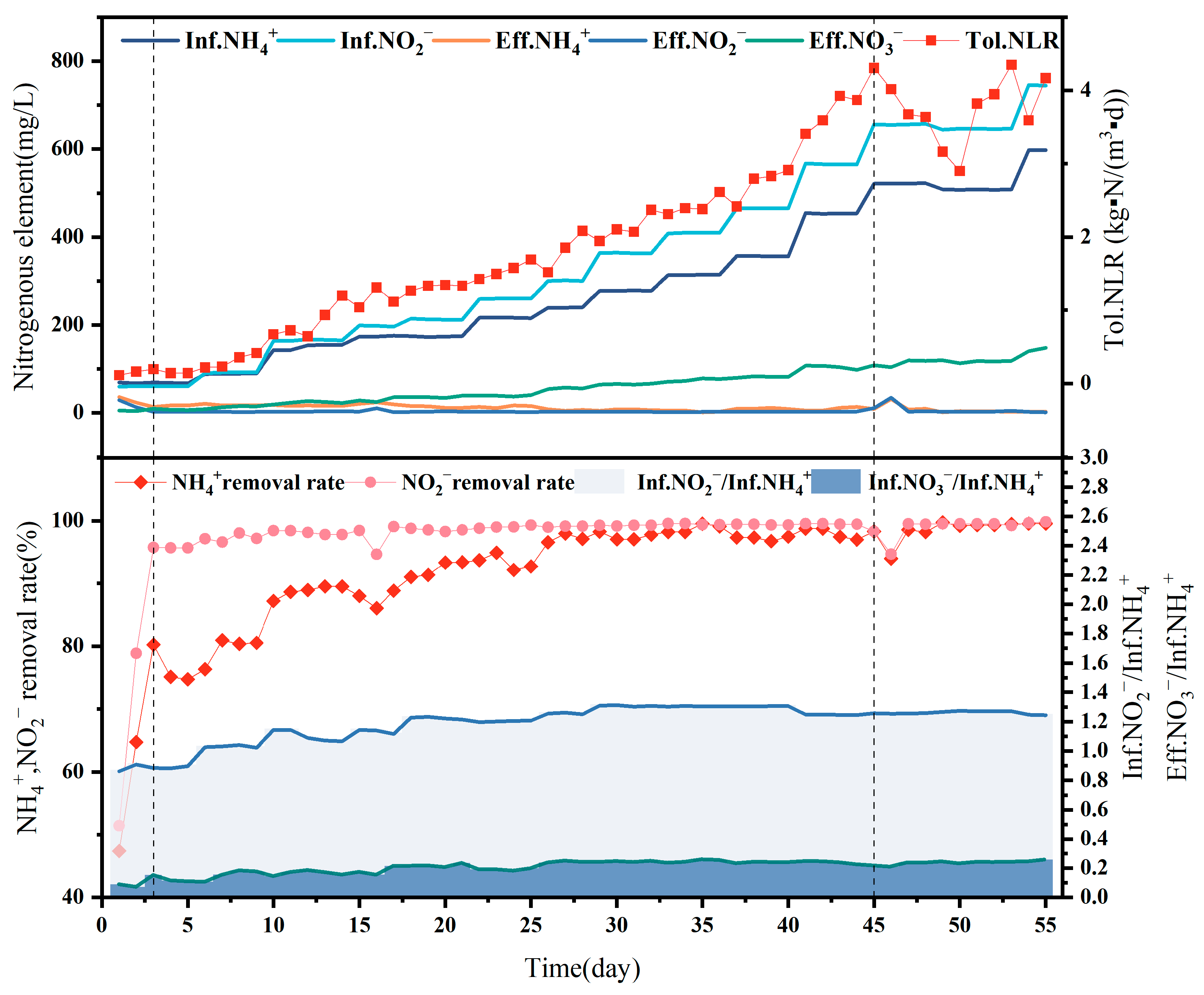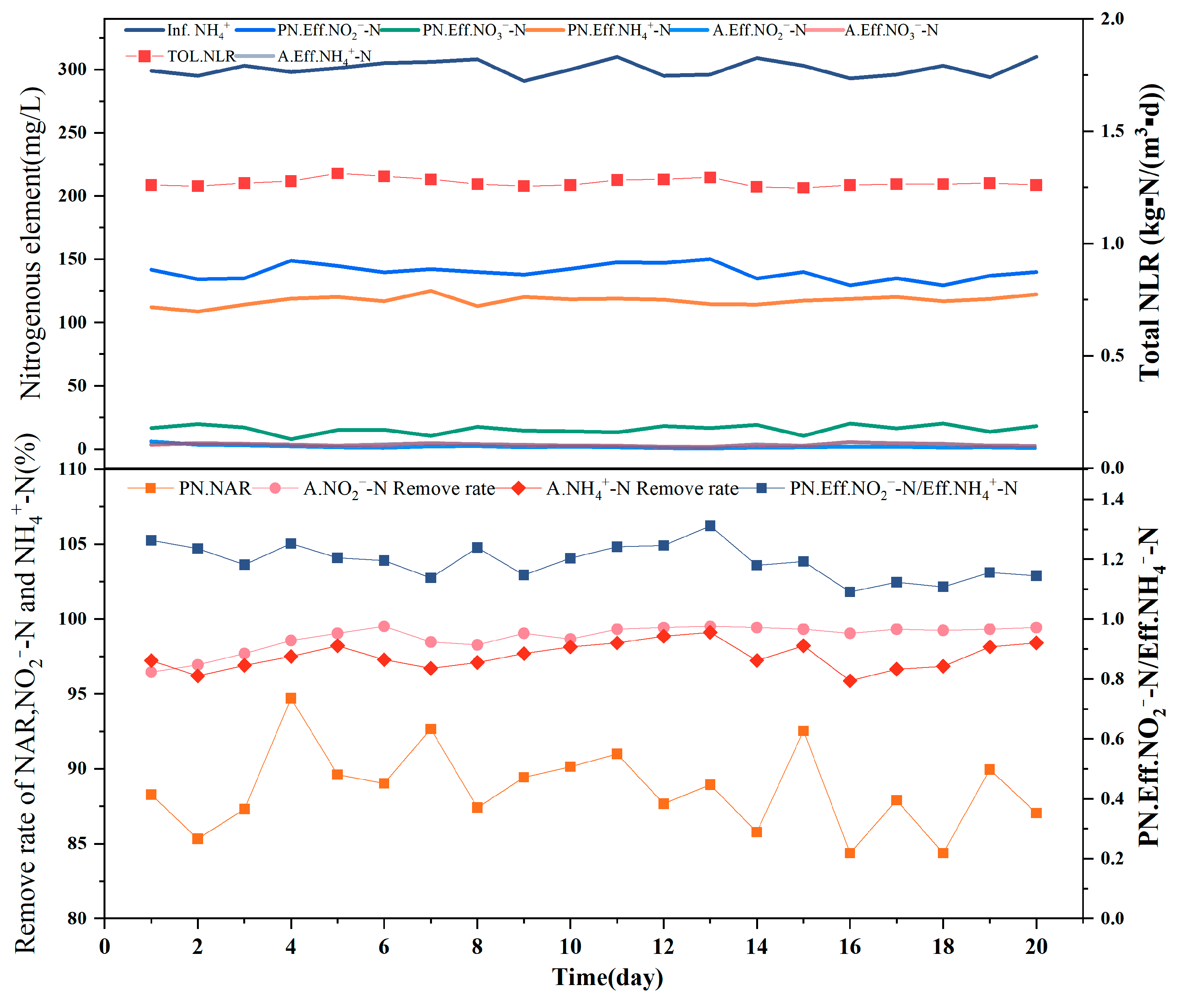Start-Up Performance and Process Kinetics of a Two-Stage Partial Nitrification–Anaerobic Ammonium Oxidation Reactor
Abstract
1. Introduction
2. Materials and Methods
2.1. Experimental Setup
2.2. Experimental Water and Inoculated Sludge
- Inoculated sludge:
2.3. Analysis Methods
2.3.1. Water Quality Analysis
2.3.2. Data Analysis
3. Discussion
3.1. PN Section Reactor Start-Up
3.2. A-Section Reactor Start-Up
3.3. Joint Operation
3.3.1. Partial Nitrification Stage
3.3.2. Anammox Stage
3.4. Growth Kinetics Analysis
3.5. Analysis of Process Dynamics
4. Conclusions
- (1)
- The results of this experiment were based on an artificial water distribution, and further in-depth research is required to determine the water quality in an actual complex.
- (2)
- This experiment has not yet been conducted from a microbial point of view, and follow-up experiments should be supplemented with other techniques such as scanning electron microscopy and DNA identification.
- (3)
- Increasing the load in an anaerobic ammonia oxidation reactor will result in pipe blockage, impacting the performance of the reactor, and this effect should be noted during any further experimental processes.
- (4)
- The combined processes of nitrosation and anaerobic ammonia oxidation produce nitrate nitrogen, and subsequent research could address the application of this reaction in further analysis and research.
Author Contributions
Funding
Institutional Review Board Statement
Informed Consent Statement
Data Availability Statement
Conflicts of Interest
References
- Chen, X.; Jiang, X.; Huang, W. Evaluation and mechanism of ammonia nitrogen removal using sediments from a malodorous river. R. Soc. Open Sci. 2018, 5, 114432. [Google Scholar] [CrossRef] [PubMed]
- Rahimi, S.; Modin, O.; Mijakovic, I. Technologies for biological removal and recovery of nitrogen from wastewater. Biotechnol. Adv. 2020, 43, 107570. [Google Scholar] [CrossRef] [PubMed]
- Yuan, Y.; Li, X.; Li, B.-L. Autotrophic nitrogen removal characteristics of PN-anammox process enhanced by sulfur autotrophic denitrification under mainstream conditions. Bioresour. Technol. 2020, 316, 123926. [Google Scholar] [CrossRef] [PubMed]
- Bao, R.; Xu, J.; Zhang, Y. Start-up and operation control of short-range nitrification and denitrification in multistage AO process. Water Purif. Technol. 2023, 42, 95–103. [Google Scholar]
- Piculell, M.; Suarez, C.; Li, C.; Christensson, M.; Persson, F.; Wagner, M.; Hermansson, M.; Jönsson, K.; Welander, T. The inhibitory effects of reject water on nitrifying populations grown at different biofilm thickness. Water Res. 2016, 104, 292–302. [Google Scholar] [CrossRef] [PubMed]
- Wen, R.; Jin, Y.; Zhang, W. Application of the Anammox in China—A Review. Int. J. Environ. Res. Public Health 2020, 17, 1090. [Google Scholar] [CrossRef] [PubMed]
- Wu, L.; Yan, Z.; Huang, S.; Li, J.; Su, B.C.; Wang, Y.; Peng, Y. Rapid start-up and stable maintenance of partial nitrification-anaerobic ammonium oxidation treatment of landfill leachate at low temperatures. Environ. Res. 2020, 191, 110131. [Google Scholar] [CrossRef] [PubMed]
- Ye, M.; Li, Y.-Y. Methanogenic treatment of dairy wastewater: A review of current obstacles and new technological perspectives. Sci. Total Environ. 2023, 866, 161447. [Google Scholar] [CrossRef] [PubMed]
- Rong, C.; Luo, Z.; Wang, T.; Qin, Y.; Wu, J.; Guo, Y.; Hu, Y.; Kong, Z.; Hanaoka, T.; Sakemi, S.; et al. Biomass retention and microbial segregation to offset the impacts of seasonal temperatures for a pilot-scale integrated fixed-film activated sludge partial nitritation-anammox (IFAS-PN/A) treating anaerobically pretreated municipal wastewater. Water Res. 2022, 225, 119194. [Google Scholar] [CrossRef]
- Wu, L.; Shen, M.; Li, J.; Huang, S.; Li, Z.; Yan, Z.; Peng, Y. Cooperation between partial-nitrification, complete ammonia oxidation (comammox), and anaerobic ammonia oxidation (anammox) in sludge digestion liquid for nitrogen removal. Environ. Pollut. 2019, 254, 112965. [Google Scholar] [CrossRef]
- Al-Hazmi, H.E.; Hassan, G.K.; Maktabifard, M.; Grubba, D.; Majtacz, J.; Mąkinia, J. Integrating conventional nitrogen removal with anammox in wastewater treatment systems: Microbial metabolism, sustainability and challenges. Environ. Res. 2022, 215, 114432. [Google Scholar] [CrossRef] [PubMed]
- Guo, Y.; Luo, Z.B.; Shen, J.H.; Li, Y.Y. The main anammox-based processes, the involved microbes and the novel process concept from the application perspective. Front. Environ. Sci. Eng. 2022, 16, 84. [Google Scholar] [CrossRef]
- Lackner, S.; Gilbert, E.M.; Vlaeminck, S.E.; Joss, A.; Horn, H.; van Loosdrecht, M.C. Loosdrecht Full-scale partial nitritation/anammox experiences—An application survey. Water Res. 2014, 55, 292–303. [Google Scholar] [CrossRef] [PubMed]
- Wei, Y.; Jin, Y.; Zhang, W. Domestic Sewage Treatment Using a One-Stage ANAMMOX Process. Int. J. Environ. Res. Public Health 2020, 17, 3284. [Google Scholar] [CrossRef] [PubMed]
- Xu, Y.; Xu, Y.; Li, T.; Wang, G.; Dai, X. Two-step partial nitrification-anammox process for treating thermal-hydrolysis anaerobic digester effluent: Start-up and microbial characterisation. J. Clean. Prod. 2020, 252, 119784. [Google Scholar] [CrossRef]
- Lu, D.; Gong, H.; Diao, S.; Shi, W.; Yin, R.; Dai, X. Enhanced sludge settlement of two stage PN/Anammox for reject water treatment with respective diatomite addition. Sci. Total Environ. 2023, 877, 162784. [Google Scholar] [CrossRef] [PubMed]
- Chen, Y.; Zhao, Z.; Liu, H.; Ma, Y.; An, F.; Huang, J.; Shao, Z. Achieving stable two-stage mainstream partial-nitrification/anammox (PN/A) operation via intermittent aeration. Chemosphere 2020, 245, 125250. [Google Scholar] [CrossRef] [PubMed]
- Cao, S.; Koch, K.; Duan, H.; Wells, G.F.; Ye, L.; Zhao, Y.; Du, R. In a quest for high-efficiency mainstream partial nitritation-anammox (PN/A) implementation: One-stage or two-stage? Sci. Total Environ. 2023, 883, 163540. [Google Scholar] [CrossRef] [PubMed]
- Mosquera-Corral, A.; Gonzalez, F.; Campos, J.L.; Mendez, R. Partial nitrification in a SHARON reactor in the presence of salts and organic carbon compounds. Process Biochem. 2005, 40, 3109–3118. [Google Scholar] [CrossRef]
- Li, S.; Xue, T.; Li, W. Study on initiating short-range nitrification of high ammonia nitrogen wastewater. J. Fuyang Norm. Univ. (Nat. Sci. Ed.) 2020, 37, 28–33. [Google Scholar]
- Perez, J.; Costa, E.; Kreft, J.-U. Conditions for Partial Nitrification in Biofilm Reactors and a Kinetic Explanation. Biotechnol. Bioeng. 2009, 103, 282–295. [Google Scholar] [CrossRef] [PubMed]
- Adams, M.; Xie, J.; Kabore, A.w.J.; Chang, Y.; Xie, J.; Guo, M.; Chen, C. Research advances in anammox granular sludge: A review. Crit. Rev. Environ. Sci. Technol. 2022, 52, 631–674. [Google Scholar] [CrossRef]
- Tang, C.-J.; Zheng, P.; Hu, B.-L.; Chen, J.-W.; Wang, C.-H. Influence of substrates on nitrogen removal performance and microbiology of anaerobic ammonium oxidation by operating two UASB reactors fed with different substrate levels. J. Hazard. Mater. 2010, 181, 19–26. [Google Scholar] [CrossRef] [PubMed]
- Gao, J.; Wang, R.; Li, Y.; Huang, H.; Su, X.; An, Z.; Yin, W.; Yang, L.; Rong, L.; Sun, F. Effect of aeration modes on nitrogen removal and N2O emission in the partial nitrification and denitrification process for landfill leachate treatment. Sci. Total Environ. 2022, 853, 158424. [Google Scholar] [CrossRef] [PubMed]
- Zhang, W.; Zhang, Y.; Li, L.; Zhang, X.; Jin, Y. Fast start-up of expanded granular sludge bed (EGSB) reactor using stored Anammox sludge. Water Sci. Technol. 2014, 69, 1469–1474. [Google Scholar]
- Ren, S.; Zhang, N.; Zhang, R. Challenges and countermeasures of short-range nitrification and anaerobic ammoX process. Chin. Chem. Bull. 2019, 87, 209–217+225. [Google Scholar]
- Mao, N.J.; Ren, H.Q.; Geng, J.J.; Ding, L.L.; Xu, K. Engineering application of anaerobic ammonium oxidation process in wastewater treatment. World J. Microbiol. Biotechnol. 2017, 33, 153. [Google Scholar] [CrossRef] [PubMed]
- Chen, C.; Song, Y.; Yuan, Y. Study on start-up and connection process of short-range nitrification and anaerobic ammoX plant. Water Treat. Technol. 2019, 45, 104–109+114. [Google Scholar]
- Fujikawa, H. Prediction of Competitive Microbial Growth. Biocontrol Sci. 2016, 21, 215–223. [Google Scholar] [CrossRef]
- Istok, J.D.; Park, M.; Michalsen, M.; Spain, A.M.; Krumholz, L.R.; Liu, C.; McKinley, J.; Long, P.; Roden, E.; Peacock, A.D.; et al. A thermodynamically-based model for predicting microbial growth and community composition coupled to system geochemistry: Application to uranium bioreduction. J. Contam. Hydrol. 2010, 112, 1–14. [Google Scholar] [CrossRef]
- Okpokwasili, G.C.; Nweke, C.O. Microbial growth and substrate utilization kinetics. Afr. J. Biotechnol. 2006, 5, 305–317. [Google Scholar]
- Li, Y.; Cui, N.; Xuan, K.; Xu, D.; Wang, D.; Li, C.; Li, Z.; Wang, Y. Start-up performance and process kinetics of a UASB-Anammox reactor at low substrate concentration. J. Environ. Chem. Eng. 2021, 9, 106726. [Google Scholar] [CrossRef]
- Yuan, Q.; Zhang, Y.; Xue, X.; Wang, C.; Ding, N.; Xu, H.; Sun, Y. Morphological, kinetic, and microbial community characterization of anammox bacteria with different inoculations and biofilm types for low-ammonium wastewater treatment. J. Water Process Eng. 2022, 47, 102748. [Google Scholar] [CrossRef]
- Debik, E.; Coskun, T. Use of the Static Granular Bed Reactor (SGBR) with anaerobic sludge to treat poultry slaughterhouse wastewater and kinetic modeling. Bioresour. Technol. 2009, 100, 2777–2782. [Google Scholar] [CrossRef] [PubMed]






| Category | Pharmaceuticals | Concentration | Pharmaceuticals | Concentration |
|---|---|---|---|---|
| Experimental water | (NH4)2SO4 | 500–5500 mg/L | CaCl2·2H2O | 0.113 g/L |
| KH2PO4 | Formulated by concentration | MgSO4·7H2O | 0.1 g/L | |
| NaHCO3 | Formulated by concentration | Trace elements 1 and 2 | 0.5 and 1 mL/L | |
| Trace elements I | FeSO4·7H2O | 10 | C10H14N2Na2O3 | 5.6 |
| MnCl2·4H2O | 0.352 | CoCl2·6H2O | 0.096 | |
| Trace elements II | NiCl2·6H2O | 0.08 | CuSO4·5H2O | 0.1 |
| ZnSO4·7H2O | 0.172 | Na2SeO4·10H2O | 0.105 | |
| NaMoO4·2H2O | 0.11 | C10H14N2Na2O3 | 5.0 |
| Model | R2 | ||||
|---|---|---|---|---|---|
| Logistic model | K | a | |||
| 4.470 | 2.777 | 0.0903 | - | 0.9528 | |
| Modified logistic model | K | r | |||
| 4.469 | 8.609 | 0.1009 | 0.9528 | ||
| Modified Gompertz model | K | r | |||
| 5.536 | 6.152 | 0.0918 | 0.9535 | ||
| Modified Boltzmann model | K | M | tc | td | |
| 4.610 | 0.113 | 32.595 | 10.953 | 0.9507 | |
| Time (d) | HRT (Hydraulic Retention Time) (h) |
|---|---|
| 1–10 | 4.5 |
| 21–20 | 2.5 |
| 21–30 | 2.2 |
| 31–40 | 2 |
| 41–55 | 2.3 |
| Grau second-order model | |
| R2 | 0.9984 |
| a | 1.0163 |
| b | 0.0361 |
Disclaimer/Publisher’s Note: The statements, opinions and data contained in all publications are solely those of the individual author(s) and contributor(s) and not of MDPI and/or the editor(s). MDPI and/or the editor(s) disclaim responsibility for any injury to people or property resulting from any ideas, methods, instructions or products referred to in the content. |
© 2024 by the authors. Licensee MDPI, Basel, Switzerland. This article is an open access article distributed under the terms and conditions of the Creative Commons Attribution (CC BY) license (https://creativecommons.org/licenses/by/4.0/).
Share and Cite
Wang, D.; Ji, Y.; Zhang, W.; Guo, X.; Wen, G.; Wu, H.; Fan, X.; Dong, K. Start-Up Performance and Process Kinetics of a Two-Stage Partial Nitrification–Anaerobic Ammonium Oxidation Reactor. Water 2024, 16, 1036. https://doi.org/10.3390/w16071036
Wang D, Ji Y, Zhang W, Guo X, Wen G, Wu H, Fan X, Dong K. Start-Up Performance and Process Kinetics of a Two-Stage Partial Nitrification–Anaerobic Ammonium Oxidation Reactor. Water. 2024; 16(7):1036. https://doi.org/10.3390/w16071036
Chicago/Turabian StyleWang, Dunqiu, Yipeng Ji, Wenjie Zhang, Xiaoying Guo, Guan Wen, Huihao Wu, Xiangyu Fan, and Kun Dong. 2024. "Start-Up Performance and Process Kinetics of a Two-Stage Partial Nitrification–Anaerobic Ammonium Oxidation Reactor" Water 16, no. 7: 1036. https://doi.org/10.3390/w16071036
APA StyleWang, D., Ji, Y., Zhang, W., Guo, X., Wen, G., Wu, H., Fan, X., & Dong, K. (2024). Start-Up Performance and Process Kinetics of a Two-Stage Partial Nitrification–Anaerobic Ammonium Oxidation Reactor. Water, 16(7), 1036. https://doi.org/10.3390/w16071036







